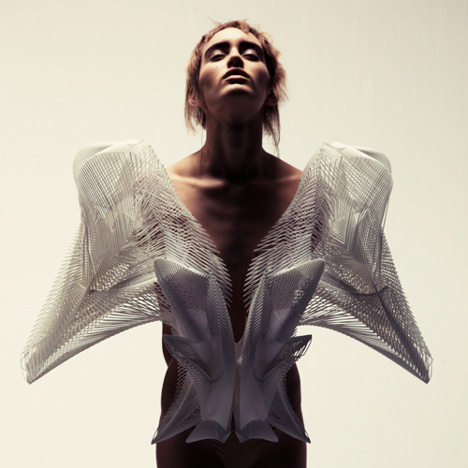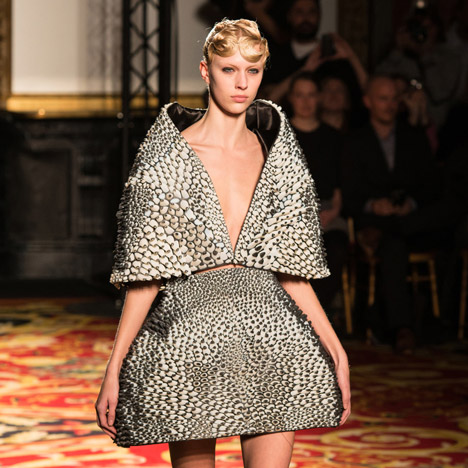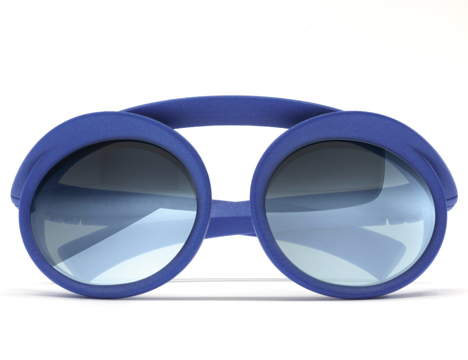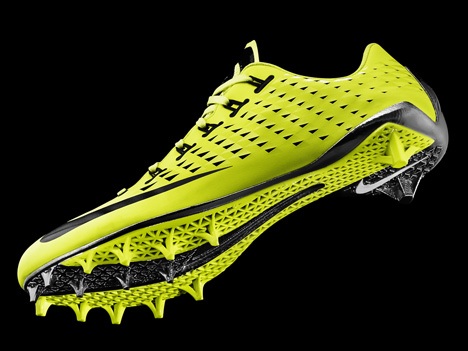
"3D printing will infiltrate fashion through streetwear, not haute couture"
Even though 3D-printed haute couture garments have been gracing the catwalks, the real breakthroughs in printed clothing will come from more practical and subversive quarters, reports Claire Barrett in this article for our one-off magazine Print Shift. Above image is by Petrovsky & Ramone.
Despite resistance, 3D printing is infiltrating the world of fashion – and it’s tech-savvy youngsters who are setting the pace.
“It’s funny,” laughs fashion designer Iris van Herpen, “I was raised without television, we didn’t have a computer and I think we were the last people to get the internet.” Today, van Herpen is the poster girl for 3D printing in the fashion industry. She creates incredible designs that have had Björk and Lady Gaga’s stylists reaching for the phone.
Van Herpen was intuitively drawn to 3D printing. “Previously, I’d have something in my head that was three-dimensional, but first I’d have to translate it into a two-dimensional format, such as a drawing, in order to present it,” she says. “That way of working feels really old-school. With 3D printing, it was the first time I could immediately translate the 3D image I had in my mind, first to a 3D computer model, and then into actual three dimensionality using the printer.”
Computers also offered van Herpen a level of complexity that would be otherwise unachievable. Her inaugural 3D-printed range, Crystallization, was the first-ever catwalk collection to feature 3D printing. This collaboration with London-based architect Daniel Widrig was launched in 2010 and produced a series of dramatic, sculptural pieces that were closer to body armour than clothing (one of the collection’s pieces is featured on the cover of this magazine).
Widrig and van Herpen collaborated again in 2011 on the Escapism collection, which this time featured delicate, coral-like forms that were moderately more wearable than their previous work.

But van Herpen’s latest collection, Voltage – shown in January this year – makes real headway towards wearability. The designer worked with Belgium-based 3D-printing company Materialise to develop an innovative new textile that is being billed as the first printable material that is flexible and durable enough to be worn – and to be put in the washing machine.
Called TPU 92A-1, the material was used to print an outfit that van Herpen designed in collaboration with Austrian architect Julia Koerner. A black lacy number, the dress looks like a fine spider’s web woven over the body and appears at first sight as if it is made from delicate textile fibres rather than laser-sintered plastic.
“I wanted people to think the dress was woven or handmade,” says van Herpen. “But if you look closely, you couldn’t have done this by hand. It would have been impossible and that’s why I used 3D printing.”
This kind of collaboration between fashion designers and the materials industry will be essential in future, says Mark Miodownik, professor of materials and society at University College London. “Designers will become materials experts, and vice versa. No one has thought about that too deeply yet, but it’s important.”
“It takes time,” says van Herpen. “You can’t design new materials for every season, but if you’re at least able to create something new every one or two years, then you have more control of your design process, as you’re actually giving direction to the material.”
Van Herpen’s Voltage collection included a second 3D-printed outfit that involved a similarly novel fabric. In collaboration with architect and MIT professor Neri Oxman, she produced a skirt and cape covered in a texture resembling clusters of seashells that was printed using Stratasys’ Objet Connex multi-material printing technology. The garments consist of two entirely different materials, one hard and one soft, that were printed together to provide different performance characteristics.
For the first time, van Herpen was able to specify flexibility within her garments. “We could say, ‘I want the arms really flexible, but then the middle not so flexible and the end really flexible again,’” she explains.
With Oxman’s expertise, van Herpen could also control the colouring by including it within the digital file, rather than adding it at a later stage.
Other designers and their celebrity clients are starting to experiment with 3D-printed outfits. In March, the burlesque performer Dita Von Teese modelled a floor-length 3D-printed gown by New York designer Michael Schmidt, who had collaborated on it with architect Francis Bitonti. Laser-sintered by Shapeways, the garment is constructed of 17 meshed pieces that flex to allow movement. The elements were hand-linked together, then polished, sprayed black and finished with 12,000 black Swarovski crystals.
It wasn’t the first time manufacturer Shapeways appeared in the fashion press: in 2011 the company printed what was billed as the world’s first entirely 3D-printed, ready-to-wear garment. The N12 bikini, designed by Continuum Fashion, can be purchased through Shapeways’ website for $300. The bikini is made up of tiny inflexible parts that are laser-sintered in nylon and joined by nylon springs that allow it to flex.
While the catwalk has been relatively slow to embrace 3D printing, designers of accessories such as shoes and jewellery have been quicker on the uptake. “They’re much closer to product design and architecture, both of which have a long history of using this technology,” says Philip Delamore, director of the Digital Fashion Studio at the London College of Fashion. “Footwear designers, in particular, get really excited about 3D printing because it means they can offer something truly unique. For example, they don’t have to buy an off-the-shelf heel.”
Last year, three London College of Fashion MA students – Hoon Chung, Kerrie Luft and Ross Barber – produced 3D-printed shoes that were worn down the catwalk at their graduation show. “It was exciting,” says Delamore. “The interest was phenomenal.”
Indeed van Herpen collaborated with Dutch shoe company United Nude to create 3D-printed shoes featuring a dramatic curved heel for her 2011 Capriole collection.
Jewellery designer Silvia Weidenbach, a recent graduate of the Royal College of Art, originally trained in traditional silversmithing but discovered 3D printing during her MA degree. With limited computer skills, the key to her accessing this technology was her discovery of the “haptic arm”. The device is an articulated limb that allows the user to manipulate 3D files on screen as if they were physical objects. As the user manipulates a tool mounted on the end of the arm, the movement is captured and translated to the computer screen.
This meant Weidenbach could push and pull the arm as though she was working with clay. “I could be really wild. There was no gravity and I directly got feedback,” she says.

For Weidenbach, the additional attraction of 3D printing was that she could make one-off pieces. Thus it was a much quicker way of working. Her laser-sintered Fractal Invention collection went on to win the Jerwood Makers Open prize last year. Because the jewellery is made from flexible nylon, the gemstones cleverly click in rather than requiring any setting.
Designer Ron Arad is also using this technology to produce accessories. Arad was among the first product designers to experiment with 3D printing when he created his Not Made By Hand, Not Made in China collection of jewellery, vessels and sculpted objects back in 2000, before it became a viable method of producing products. But last year, Arad launched a range of sunglasses for PQ Eyewear that are laser-sintered in one piece with flexible joints instead of hinges.
The ease with which 3D printing allows easy customisation of products means it could be ideal for the fashion industry, where every customer has a unique shape and differing tastes. Yet despite that synergy, the technology has several hurdles to overcome before it is widely utilised. The biggest is that the fashion industry is “not very computerised,” according to designer Janne Kyttanen of Freedom of Creation.
“Fashion designers focus on the material – they feel it, they look at how it drapes and how it moves with the motion of the body,” says Kyttanen. “But now we’re taking away this element of their work, so they need to change their thinking to ‘How is it going to come out of the machine? How is it going to function?’” Rather than embrace these issues, Kyttanen believes the industry has chosen to ignore them.
Another big barrier is the limited palette of available materials. “3D printing wasn’t designed for designers – it was designed for engineers,” says London College of Fashion’s Delamore. “Primarily, it came from the car and aerospace industries, and the materials were developed for engineering applications. Designers are always inventive in terms of picking up new technologies and playing with them, but 3D printing uses materials that were meant for other purposes.”
He adds: “You could say that until [a 3D-print manufacturer] thinks with a designer’s perspective about the materials we actually want to make things in, we’ll continue down our current path.”
There are also generational issues at work. 3D technology allows greater freedom for young designers, who are able to produce runs of a few units rather than thousands, realising designs that, previously, would only ever have existed on paper. “Five years ago, most students arrived with no idea of what 3D printing was,” says Delamore. “Now they see it as another tool.”
It’s enterprising, up-and-coming designers such as these that Charlie Porter, men’s fashion critic for the Financial Times, believes will kick-start a change within the industry. This group has a different notion of what constitutes great fashion design. “Over the past few years, one of the biggest developments has been in the area of sportswear – in really unglamorous things like trainers, things that aren’t necessarily viewed as ‘fashion’,” says Porter. “Young designers in London are still making things by hand, but the thing they’re interested in is sportswear. They’re not into tailoring.”
In March, sports brand Nike released the first commercial sportswear product to include 3D-printed elements. Its Vapor Laser Talon American football boots are fitted with a laser-sintered footplate and studs. Using 3D-printing technology meant Nike was able to prototype the boot and make alterations in a much shorter timeframe than normal – it allows design updates to be made in days rather than months. The new boot is significantly lighter than previous examples and has made a significant dent in the “40 yard dash” time, the standard measure used by scouts to assess an athlete’s speed and ability.“3D printing will probably infiltrate fashion through streetwear rather than haute couture,” says Porter, “because [high-end] fashion isn’t looking for something to replace what’s there at the moment.”
Shoppers may not be ready for printed clothes either, says Delamore. “Designers are creating iconic museum pieces, but it’s not yet a consumer-level technology,” he says. “We’re used to wearing natural materials, and even though we do wear nylon and polyester in our clothes, the type of drape and feel and quality that we’d expect from something that’s been 3D-printed is a long way off.”

Delamore thinks developments in bioprinting – where living tissue like human skin and organs are 3D-printed – offer greater promise. “Really exciting things are happening around medical and biomaterials,” he enthuses. “Perhaps these advances will be picked up and brought into the fashion world. I’d imagine that if you get into printing protein and things like that, printing silks and those sorts of materials would be the next step.”
Chris Sanderson, strategy and insight director at the Future Laboratory, thinks the potential for 3D printing is huge but believes it goes hand in hand with other 3D technologies like 3D weaving and 3D knitting – where fabric is woven or knitted in the round to create tubes of fabric, rather than as flat pieces.
3D technology will become relevant to the fashion industry when it realises that it “gives [them] an opportunity to work with the human body in a very, very different way, and one that most of them aren’t really used to,” Sanderson says. “Most of our clothing is still manufactured and produced in two dimensions. But fashion is about three dimensions. It gets interesting when something is made to fit the human body.”
Click here for more from our interview with Iris van Herpen.